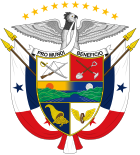
Arnulfo Arias Madrid was a Panamanian politician, medical doctor, and writer who served as the President of Panama from 1940 to 1941, again from 1949 to 1951, and finally for 11 days in October 1968.

Roberto Francisco Chiari Remón was the President of Panama in 1949 and from 1960 to 1964. He belonged to the Liberal Party.
Daniel Chanis Pinzón was Panamanian politician and physician. As First Vice President of Domingo Díaz Arosemena he became President of Panama on July 28, 1949, and served until November 20, 1949, when he was forcibly ousted by police chief José ("Chichi") Remón. He was succeeded by Díaz Arosemena's Second Vice President, Roberto Chiari. He belonged to the Liberal Party.

Florencio Harmodio Arosemena Guillén was the 6th President of Panama from October 1, 1928 to January 3, 1931. He belonged to the Liberal Party.

The Panameñista Party is a nationalist political party in Panama. It was the third largest party by number of adherents with 256,138 members.
Panama is a transcontinental country spanning the southern part of North America and the northern part of South America.

General elections were held in Panama on 7 May 1989, with the goal of electing both a new President of the Republic and a new Legislative Assembly. The two primary candidates in the presidential race were Guillermo Endara, who headed Democratic Alliance of Civic Opposition (ADOC), a coalition opposed to military ruler Manuel Noriega, and Carlos Duque, who headed the pro-Noriega Democratic Revolutionary Party (PRD).

General elections were held in Panama on 27 May 1948, electing both a new President of the Republic and a new National Assembly.

Constitutional Assembly elections were held in Panama on 5 May 1945.

General elections were held in Panama on 7 June 1936, electing both a new President of the Republic and a new National Assembly.

General elections were held in Panama on 5 August 1928 to elect both a new President of the Republic and a new National Assembly.
The Republican Party was a Panamanian right-wing political party.

General elections were held in Panama on 2 September 1924 to elect both a new President of the Republic and a new National Assembly.

Presidential elections were held in Panama on 25 June 1916.
The Third Nationalist Party was a Panamanian conservative, radical nationalist political party.
The National Patriotic Coalition was a Panamanian conservative nationalist political party.
The National Liberation Movement was a Panamanian right-wing liberal political party.
The Renewal Party was a Panamanian right liberal political party.
The Popular Union Party was a Panamanian centrist liberal political party.
Acción Comunal was a nationalist and anti-American political movement in Panama during the 1920s and 1930s. It was responsible for a coup on January 2, 1931, that deposed President Florencio Harmodio Arosemena.





